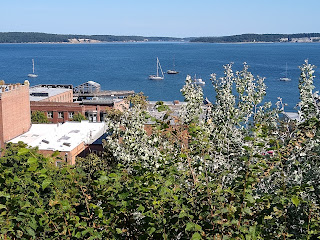The photo above was posted to a Facebook group I've joined, called Historic Olympic Peninsula, without attribution or credit. But it was so striking that I decided to re-post it here...if any viewers know where this one is from please let me know. The poster dated it to roughly 1895, and its a view of downtown Port Angeles, taken from about here and looking north. Two things jumped out at me. First, the tall ships in the harbor reminded me of my last post, which focused on tall ships anchored off of Port Townsend in 1891. Second, this photo pre-dates, but about two decades, the filling of downtown Port Angeles, which is a focus of a few of my previous posts. This view really provides a nice perspective on Port Angeles as a built-on-the-beach town. Here is the modern view (February 2022):
2/11/22
11/30/21
Tall ships in Port Townsend Bay
This 1891 view of Port Townsend Bay is enchanting for so many reasons - the bay loaded with tall ships (and one hybrid steamer), the impressively crafted buildings and docks, and the streetcar in the near frame, and the sand roadways:
 |
| 1891 view of Port Townsend and Port Townsend Bay. Image credit: Bert Kellogg collection. |
11/3/21
From Craven Peninsula to Port Townsend Canal
In 1841 explorer Charles Wilkes named the small stretch of gravel connecting Port Hadlock with Indian Island Craven Peninsula after a member of his crew, Lt Charles Craven.
The peninsula was submerged at high tides. Natives and later settlers portaged over the peninsula at high tides.
As early as the mid 1800's, there was interest in dredging the peninsula to make the channel a channel for shipping.
Finally in 1915, the peninsula was dredged and a canal was created. Local residents were promised a bridge that didn't come until 1952. Prior, residents and later the Navy on Indian Island used a variety of boats and later ferries to cross the channel.
Read more about the story of Craven Peninsula, the dredging, ferries and the bridge on this link:
10/7/21
Restoration and change on the Elwha River delta
Another perspective on short-term change on the shoreline associated in part with restoration (like this post from June), again on the Elwha River delta (like this post from 2020). This particular location is on the east side of the Elwha River delta, and was eroding rapidly between 2011 and 2015. Here is what the site looked like in 2011:
 |
| May 2011 photo of the beach on the Elwha River delta, looking up the beach from the low tide line. |
By late 2013 the beach was heavily eroded, revealing large boulders on the beach, part of a failed defensive rip-rap structure built at some point in the past:
 |
| September 2013 photo |
 |
| July 2016 photo |
 |
| July 2018 photo |
9/5/21
Mistaken Identity - #2 - Seattle's Alki Point or Orcas Island?
At least one historical hard cover Seattle photo history book and a HistoryLink post on Alki Point have presented this image as 'A Outing near Alki Point', 1889. (Alki Point is in Seattle)
When I saw both publications, the image didn't quite feel like Alki or anything near Seattle.
The large hill or mountain in the background seemed too tall and too close to be in Seattle.
Often telephoto lenses can squeeze elements together and bring mountains closer to the foreground, but I assume the photographer didn't have a 600mm lens in 1889, even on a view camera.
So I posted the image on the Facebook group "Puget Sound and Surrounds." Everyone who responded agreed it's definitely not Seattle. Maybe Chuckanut Drive, Hood Canal or.. the San Juans?
It was decided through similar photos and Google Earth that it was Orcas Island!
Here's the results!
Mistaken Identity - Blake or Waadah Island?
I follow the Facebook group History of Puget Sound and Arounds whose followers post common and sometimes less known PNW history photos.
In November 2019, group admin shared a post from another FB group showing this postcard from the early 20th century showing 'Puget Sound Indians' on the beach after fishing.
Group members felt the location was Blake Island, across from Seattle.
Right off, I knew it was Waadah Island, which borders Neah Bay. I've surfed around Neah Bay for years so know the area well.
When you enter Neah Bay, you can view Waadah Island as you just arrive in town. The island was connected to the shoreline at some point thus protecting the bay and its fishing fleet from ocean swell.
Below is the postcard and post from the history group.
Further below are images I found showing the island in different eras including (middle) the image from the book "The Sea is My Country."
8/9/21
Sekiu and the schooner Louise
This 1909 photo of the schooner Louise S. on its side in Sekiu is featured in an interpretive display about shipwrecks at Clallam Bay State Park, and I've always found it arresting.
 |
| The schooner Louise S. aground just offshore of Sekiu, WA in 1909. Photo from the Bert Kellogg collection. |
The ship itself provides a glimpse into a time period on the Olympic Peninsula when boats like this would have been a common sight sailing from coastal town to coastal town. But the other thing, of course, that this photo features is in the background...the shoreline of Sekiu. And just as the ship speaks to changes in our modes of transport, the shoreline in this 1909 photo speaks to changes in the shoreline. Here is the modern view from more or less the same spot:
 |
| 8 August 2021 photo of the boat haven in Sekiu, Washington, taken about here. |














